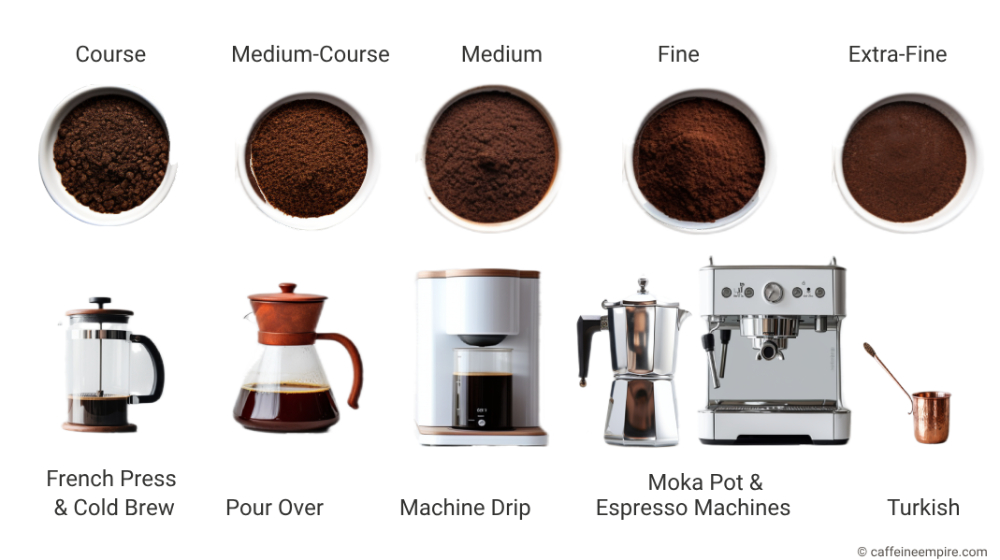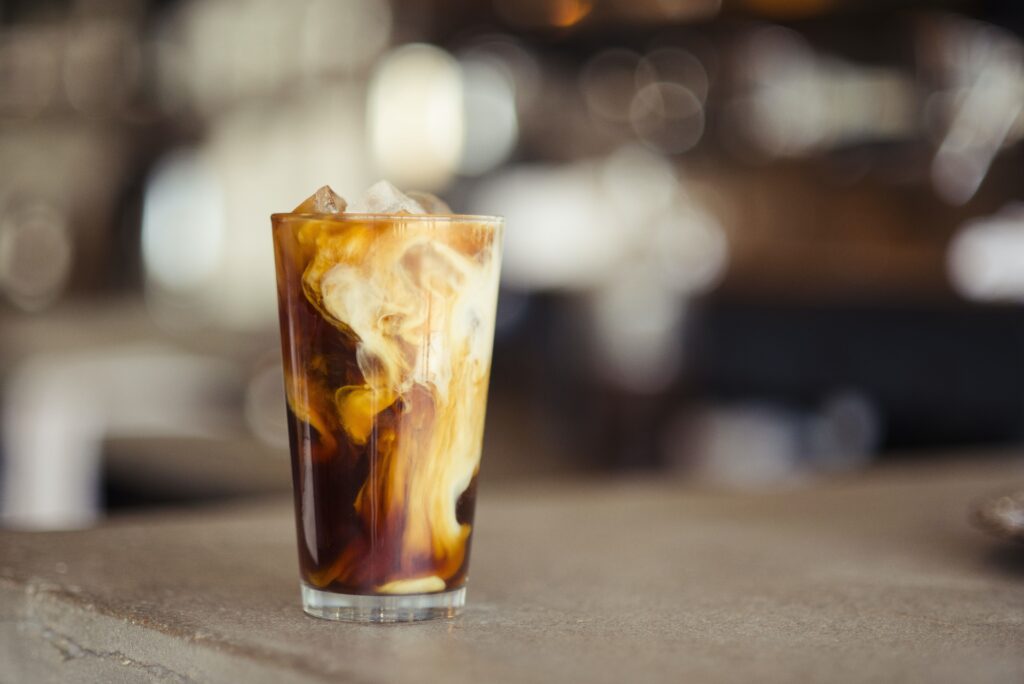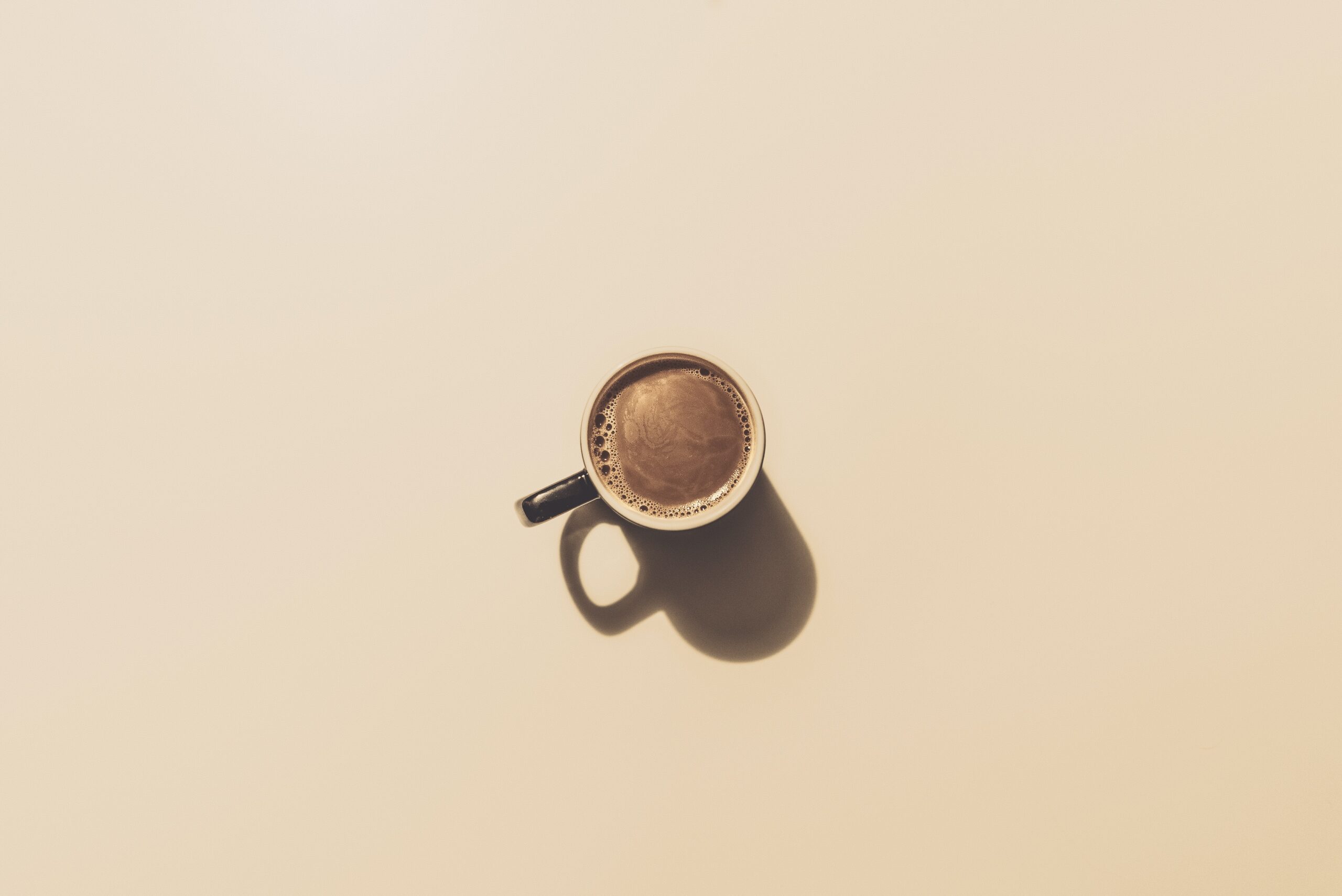Coffee Grind Chart
You’re about to embark on a delicious journey into the world of coffee grinds! This article provides a handy coffee grind chart that will help you understand the different levels of coarseness or fineness when it comes to grinding your beloved coffee beans. Whether you’re a coffee connoisseur or just starting your brewing adventures, this chart will be your trusty companion, guiding you towards the perfect grind for your preferred brewing method. Get ready to elevate your coffee brewing game and unlock a world of amazing flavors with the help of this comprehensive coffee grind chart!
Correlation between grind size and brewing method
Understanding the correlation between grind size and brewing method is vital to achieving the best possible coffee flavor. Different brewing methods require specific grind sizes to optimize the extraction process.
Coarse grind is typically preferred for French press and cold brew methods. The larger coffee particles allow for a longer steeping time, resulting in a full-bodied and flavorful cup of coffee.
Medium grind is versatile and works well for pour-over, drip brewing, and AeroPress. It balances extraction speed and flavor, producing a well-rounded cup of coffee.
Fine grind is suitable for espresso machines and Moka pots. The smaller particles allow for a quicker extraction, resulting in a concentrated and intense coffee flavor.
As the name suggests, extra fine grind is used for Turkish coffee, where it is necessary to have an extremely fine powder-like consistency to achieve optimal taste.
Impact of grind size on flavor extraction
The grind size significantly impacts the flavor extraction process. Finer grind sizes increase the surface area of the coffee particles, allowing for a faster extraction rate. This can result in stronger and more intense flavors and a higher caffeine content.
On the other hand, coarser grind sizes slow down the extraction process, leading to a milder flavor profile. This can be advantageous for delicate coffee beans that may become bitter if exposed to a prolonged extraction.
Finding the right balance between extraction time and grind size is key to achieving the desired flavor in your coffee. Experimentation and adjusting grind sizes based on personal preferences will ultimately lead to a flavor profile that suits your taste.
The Coffee Grind Chart

Coarse Grind
Characteristics of coarse grind
A coarse grind is characterized by its large coffee particles, resembling rough sand or sea salt. The individual coffee particles are more prominent than finer grinds, resulting in a unique brewing experience.
Coarse grind offers a more robust and full-bodied cup of coffee. The larger particles allow for a longer extraction time, promoting the release of rich and bold flavors. Additionally, the coarser grind size filters the coffee more effectively, resulting in a cleaner cup without excessive sediment.
Ideal brewing methods for coarse grind
The ideal brewing methods for coarse grind include the French press, cold brew, and percolator. These brewing methods require a longer steeping or brewing time to extract flavors from the coarser grind.
French press brewing involves immersing the coarse coffee grounds in hot water for several minutes. The extended steeping time allows the water to extract the rich flavors from the larger particles, resulting in a full-bodied and aromatic cup of coffee.
Cold brew, a method that involves steeping coffee grounds in cold water for an extended period, also benefits from using a coarse grind. The larger particles release the flavors slowly over time, producing a smooth and less acidic brew.
Percolator brewing relies on the circulation of boiling water through the coarse grounds multiple times. The coarse grind size ensures proper extraction and prevents overextraction, which can result in a bitter taste.
Using a coarse grind with these brewing methods allows you to experience the full spectrum of flavors in your cup of coffee, making it an ideal choice for those who prefer a strong and robust brew.

Medium Grind
Characteristics of medium grind
A medium grind falls somewhere in between coarse and fine grind, with particles about the size of granulated sugar. This versatile grind size offers a balance between extraction speed and flavor, making it suitable for a variety of brewing methods.
Medium grind allows for a moderate extraction rate, resulting in a well-rounded cup of coffee. It strikes a balance between the boldness of a coarse grind and the intensity of a fine grind, providing a pleasant flavor profile.
Best brewing methods for medium grind
The best brewing methods for medium grind include pour-over, drip brewing, and AeroPress. These methods benefit from the medium grind size, allowing for a controlled extraction rate and optimal flavor development.
Pour-over brewing involves pouring hot water over a bed of medium grind coffee grounds in a slow and controlled manner. The medium grind allows for a steady extraction rate, encouraging the flavors to develop evenly and creating a clean and vibrant cup of coffee.
Drip brewing, a popular method in coffee machines, also utilizes medium grind coffee. The water dripping onto the medium grind bed allows for an even extraction, resulting in a balanced and well-extracted brew.
AeroPress, a versatile and unique brewing method, also benefits from a medium grind. The aerodynamic principles in the AeroPress design promote a controlled extraction. The medium grind size allows for a balanced and flavorful cup with a smooth finish.
Using a medium grind, you can explore a wide range of brewing methods and experience the harmonious balance of flavors this grind size offers.
Fine Grind
Characteristics of fine grind
A fine grind consists of smaller particles resembling table salt or sand. The fine grind size is essential for specific brewing methods that require a shorter extraction time and a concentrated flavor profile.
Due to its increased surface area, fine grind provides an intense and bold flavor profile. The smaller particles allow for a quicker extraction, resulting in a vibrant cup of coffee.
Perfect brewing methods for fine grind
Brewing methods that require a fine grind include espresso machines and Moka pots. These methods utilize the increased extraction speed of fine grinds to produce an intense and concentrated coffee flavor.
Espresso machines use pressurized water to force hot water through a puck of tightly packed fine grind coffee. The quick extraction time and fine grind size contribute to espresso’s distinct flavors and crema characteristic.
Moka pots, also known as stovetop espresso makers, rely on steam pressure to brew coffee. The fine grind size ensures a rapid extraction, producing a strong and bold cup of coffee reminiscent of espresso.
Utilizing a fine grind with these brewing methods allows you to experience the concentrated flavors and strong aroma associated with the fine grind size.
Extra Fine Grind
Characteristics of extra fine grind
Extra fine grind is the finest grind size available, resembling fine powder or flour. This grind size is necessary for brewing methods that require an extremely fine consistency to achieve optimal taste.
Extra fine grind ensures maximum surface area for rapid extraction and flavor saturation. The finely ground particles facilitate quick and complete extraction, resulting in a bold and intense cup of coffee.
Suitable brewing methods for extra fine grind
Turkish coffee is the most notable brewing method that requires an extra fine grind. This traditional method involves simmering extremely fine coffee grounds in water, producing a strong and aromatic coffee beverage.
The extra fine grind enables the coffee to infuse fully and evenly into the water, providing a rich and robust flavor profile. The fine particles also contribute to the traditional Turkish coffee’s unique texture and appearance.
For those who appreciate the cultural heritage and distinctive taste of Turkish coffee, using an extra fine grind is essential to achieve an authentic and enjoyable brewing experience.

This image is property of images.unsplash.com.
The Role of Grinders
Different types of coffee grinders
Coffee grinders play a crucial role in achieving the desired grind size for your coffee. There are two main types of coffee grinders: blade grinders and burr grinders.
Blade grinders feature a spinning blade that chops the coffee beans into varying particle sizes. While blade grinders are generally more affordable, they do not offer the precision and consistency of a burr grinder. The inconsistency in grind size can lead to uneven extraction and potentially impact the flavor of your coffee.
Burr grinders, on the other hand, consist of two abrasive surfaces (burrs) that grind the beans into a uniform size. They offer greater control over the grind size and produce more consistent results. Burr grinders are available in both manual and electric varieties, catering to individual preferences and brewing methods.
Choosing the right grinder for your needs
When selecting a coffee grinder, consider your brewing preferences and budget. If you primarily brew coffee using a method that requires a specific grind size, such as espresso, investing in a burr grinder is recommended. A burr grinder will offer the precision and consistency necessary to achieve the desired grind size for your preferred brewing method.
However, if you often switch between brewing methods that require different grind sizes, a versatile grinder with adjustable settings becomes crucial. Look for a grinder that allows you to easily adjust the grind size to accommodate various brewing methods.
Additionally, consider the convenience and ease of use. Electric burr grinders are generally more efficient and faster, while manual burr grinders offer a more hands-on and portable option. Choose the grinder that aligns with your lifestyle and brewing routine.
How to adjust grinder settings
Adjusting the settings on your coffee grinder is a straightforward process. Most burr grinders have a dial or knob that allows you to select the desired grind size.
To adjust the settings, start by referring to your coffee grind chart to determine the appropriate grind size for your brewing method. Then, locate the grind size adjustment feature on your grinder. Turn the dial or knob to the desired position, aligning it with the recommended grind size on the chart.
It is essential to make small adjustments at a time and test the grind size by brewing a small batch of coffee. This allows you to fine-tune the settings until you achieve the desired flavor extraction.
Remember to keep the grind size consistent once you find the ideal setting for your preferred brewing method. Maintaining consistency in your grind size will help ensure consistent flavor in your brewed coffee.
Mistakes to Avoid when Grinding Coffee
Common grinding errors
Grinding coffee can be a straightforward process, but certain common errors can affect the quality of your brew. Avoiding these mistakes is key to achieving the best possible coffee flavor.
One common error is using the wrong grind size for your brewing method. Using a grind size that is too fine or too coarse can result in over or underextraction, leading to bitterness or weak flavors. Always refer to your coffee grind chart and ensure you are using the appropriate grind size for your chosen brewing method.
Another mistake is failing to adjust the grinder’s settings when switching between brewing methods. Each brewing method requires a specific grind size to optimize flavor extraction. By neglecting to adjust the settings, you may end up with suboptimal taste in your coffee.
Implications of incorrect grind size
Using an incorrect grind size can have implications for the flavor, aroma, and overall quality of your coffee. If the grind size is too fine, overextraction can occur, resulting in a bitter and unpleasant taste. On the other hand, if the grind size is too coarse, underextraction may happen, leading to a weak and insipid brew.
Furthermore, incorrect grind size can impact the brewing time. Finer grinds generally require a shorter brewing time, while coarser grinds need a longer steeping or brewing time. Using the wrong grind size can throw off the timing, disrupting the balance of flavors in your cup of coffee.
How to correct grind size mistakes
If you realize you have made a mistake with the grind size, do not fret. Correcting the issue is relatively simple and can have a significant impact on the outcome of your coffee.
If your coffee tastes bitter or over-extracted, indicating a grind size that is too fine, adjust your grinder to a slightly coarser setting. This change will slow down the extraction process and result in a smoother and less bitter cup of coffee.
Conversely, if your coffee tastes weak or under-extracted, indicating a grind size that is too coarse, adjust your grinder to a slightly finer setting. This adjustment will increase the extraction rate and produce a more robust and flavorful brew.
Remember to make small adjustments at a time and test the results by brewing small batches of coffee. This allows you to fine-tune the grind size until you achieve the desired flavor profile.
Maintaining Consistency in Coffee Grind
Importance of grind consistency
Maintaining consistency in your coffee grind is essential to achieving consistent flavor in your brewed coffee. Grind consistency ensures that each coffee particle extracts at a similar rate, resulting in a uniform flavor profile.
Consistency in grind size allows for precise control over the extraction process. It ensures that all the coffee particles come into contact with the water for an optimal amount of time, releasing flavors and oils in a balanced manner. Without grind consistency, there may be variances in flavor strength, acidity, and overall taste.
Furthermore, consistency allows for repeatability, allowing you to recreate your favorite cup of coffee consistently. This is crucial for those who strive to fine-tune their brewing process and achieve the desired flavor profile consistently.
Ways to ensure consistent grind size
To ensure consistent grind size, there are several steps you can take:
Invest in a quality coffee grinder: A good quality burr grinder is crucial for achieving consistent grind size. Blade grinders tend to produce inconsistent particle sizes, which can lead to variations in flavor extraction. Choosing a grinder with reliable and precise grinding mechanisms will help maintain consistency.
Calibrate your grinder: Periodically calibrating your grinder can help ensure accurate and consistent grind size. Consult the manufacturer’s instructions or seek guidance from professional resources to understand the calibration process specific to your grinder model.
Use a scale: Weighing your coffee beans before grinding them can help achieve a consistent coffee-to-water ratio, which contributes to consistent flavor extraction. A digital scale allows for precise measurements and ensures consistency in the brewing process.
Grind in batches: Grinding coffee in small batches can contribute to consistency. Grinding the entire batch at once ensures all the coffee particles are subjected to the same grinding duration, leading to uniform particle size distribution.
Clean and maintain your grinder: Regularly cleaning and maintaining your coffee grinder is essential for consistent performance. Coffee oils and residue can accumulate over time, affecting grind consistency. Follow the manufacturer’s instructions for cleaning and maintenance, keeping your grinder in optimal condition.
By following these steps, you can maintain consistency in your coffee grind, resulting in a consistently delicious cup of coffee.
How Freshness Impacts Grind Size
Relationship between coffee bean freshness and grind size
Coffee bean freshness can impact the optimal grind size for brewing. Freshly roasted coffee beans produce less carbon dioxide, making them denser and more challenging to grind. As coffee beans age, they become less dense and more brittle, allowing for easier grinding.
For fresher beans, a coarser grind size is often recommended to compensate for the increased density. A coarser grind size slows down the extraction process, allowing for the flavors to develop sufficiently despite the denser beans.
As coffee beans age, a finer grind size may be necessary to maintain extraction consistency. The less dense and more brittle nature of older beans requires a finer grind to achieve the desired extraction rate and flavor balance.
Maintaining optimal freshness for different grind sizes
To maintain optimal freshness for different grind sizes, several considerations come into play:
Proper storage: Storing your coffee beans correctly is vital to preserve their freshness. Keep your beans in an airtight container in a cool, dark place away from moisture, heat, and light. Avoid storing them in the refrigerator or freezer, as this can introduce moisture and affect the beans’ flavor.
Purchase in smaller quantities: Buying coffee beans in smaller quantities ensures that you use the freshest beans possible. If you are not consuming coffee at a high volume, consider purchasing beans in smaller batches to minimize exposure to air, which can accelerate the aging process.
Roast your own beans: For the utmost freshness, consider roasting your own coffee beans. Home roasting allows you to control the roast level and grind the beans immediately before brewing, maximizing both freshness and flavor.
Note the roast date: When purchasing coffee beans, take note of the roast date. Freshly roasted beans are typically considered at their peak within two to four weeks of the roast date. Use this information to optimize your grind size accordingly.
By understanding the relationship between grind size and freshness, as well as implementing proper storage and purchasing practices, you can ensure that your coffee beans stay fresh and flavorful, regardless of the grind size required for your preferred brewing method.
In conclusion, understanding the coffee grind chart is essential for coffee enthusiasts aiming to brew their perfect cup of joe. By utilizing the recommended grind sizes for different brewing methods, you can optimize flavor extraction and achieve consistency in your brew. Experimenting with grind sizes and avoiding common mistakes ensures that you unlock the full potential of your coffee beans, resulting in a satisfying and flavorful coffee experience. So, grab your coffee grinder, consult the coffee grind chart, and embark on a journey of exploring different grind sizes to elevate your coffee brewing skills.






